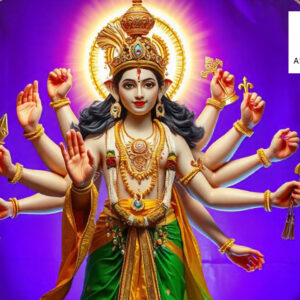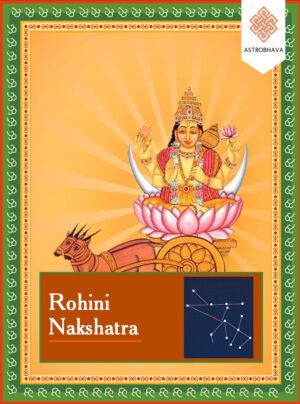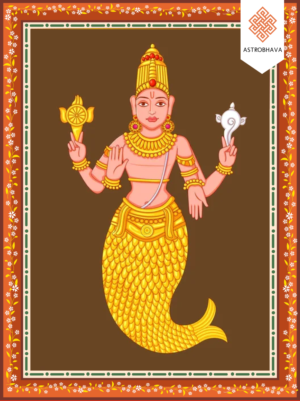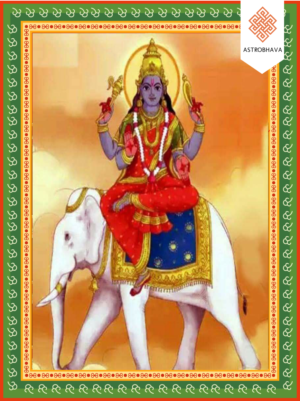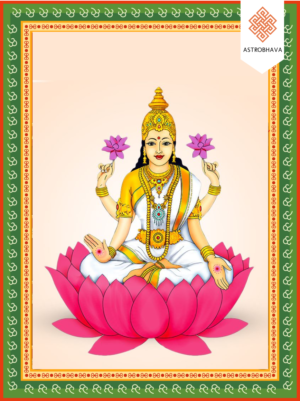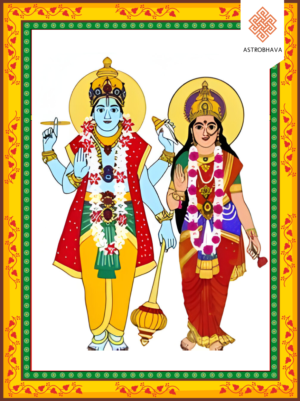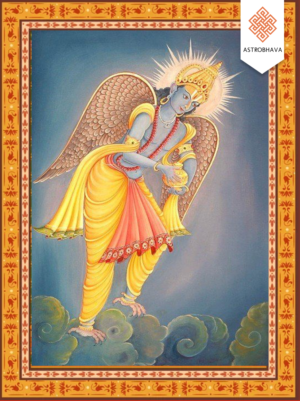Dhumavati Goddess: A Guide to Mythology, Japa and Worship
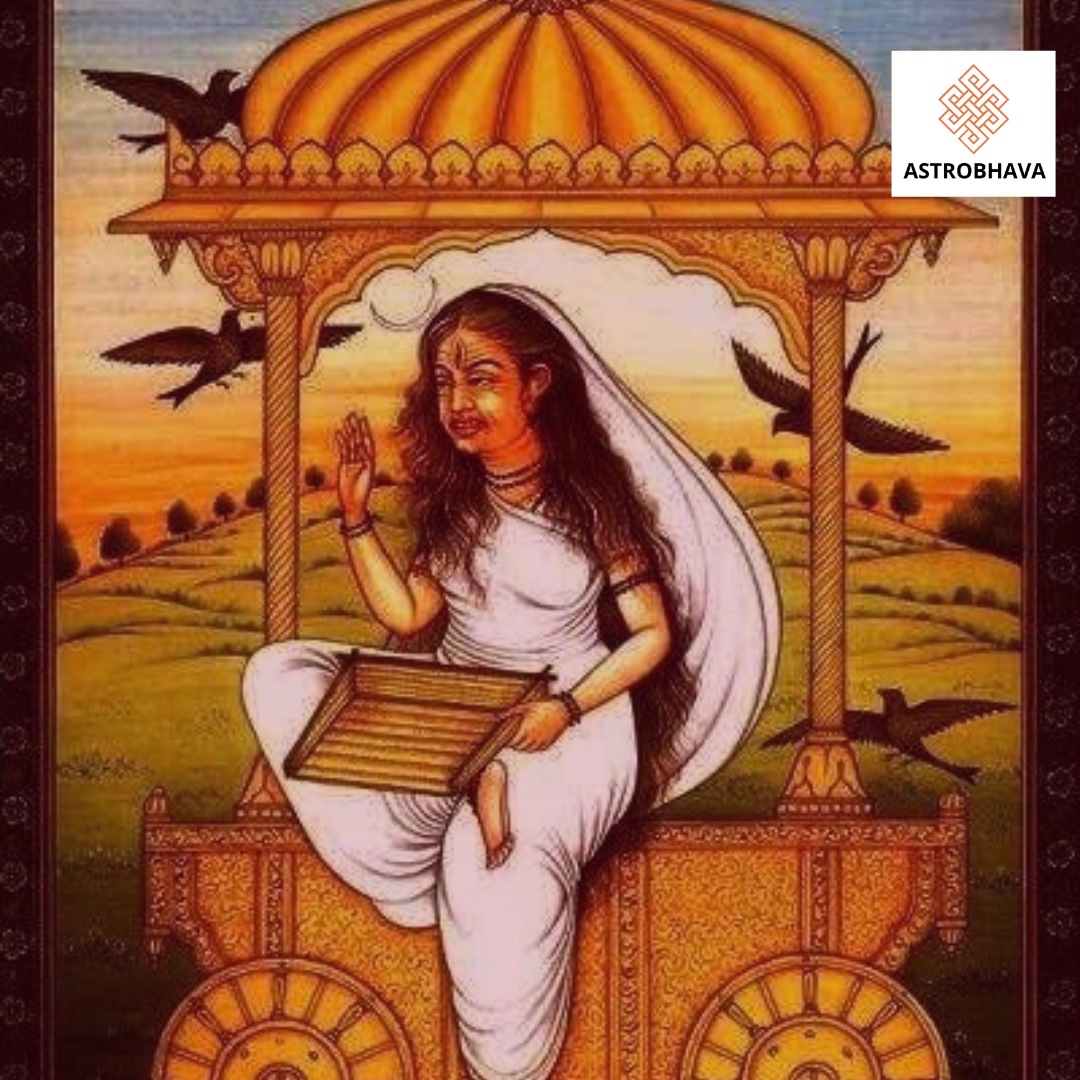
About Dhumavati Goddess
Dhumavati is often depicted as a widow, draped in old, tattered clothes, riding a chariot without horses. Her imagery symbolizes detachment, dissolution, and the power of the void. She represents the state of existence that transcends material desires and attachments, embodying the wisdom that arises from life’s trials and tribulations.
While her form may seem fearsome, Dhumavati is a compassionate goddess for those who seek liberation (moksha) and spiritual growth. She is the destroyer of illusions and the granter of ultimate knowledge, helping devotees confront their fears and embrace the truth of impermanence.
Historical Context Related to Dhumavati
The origins of Dhumavati can be traced back to ancient Tantric texts, where she is revered as one of the ten Mahavidyas—each representing a unique aspect of divine wisdom. Her name, derived from the Sanskrit word “Dhūma,” meaning smoke, reflects her connection to the ephemeral and intangible.
In mythology, Dhumavati is said to have emerged from Sati, the first consort of Lord Shiva. When Sati immolated herself in the sacrificial fire of her father’s yajna, her smoky essence transformed into Dhumavati. This myth underscores her association with loss, transformation, and spiritual awakening through adversity.
How to Worship Dhumavati
Preparation for Worship
1. Choosing the Right Time
- The best time to worship Goddess Dhumavati is during the Shukla Paksha Ashtami (8th day of the waxing moon) or on Dhumavati Jayanti, which falls on the Ashtami tithi of the Jyeshtha month.
- Midnight or the Brahma Muhurta (early morning) is considered auspicious for her worship.
2. Setting Up the Altar
- Idol or Picture: Place an image or idol of Goddess Dhumavati on a clean altar. If unavailable, a symbolic yantra (geometrical representation) can be used.
- Colors and Decorations: Use black or dark-colored cloth as the backdrop for the altar, as these are associated with her energy.
- Offerings: Arrange offerings such as sesame seeds, mustard oil, black cloth, dry fruits, and flowers like hibiscus or black mustard flowers.
3. Personal Preparation
- Take a bath and wear clean, preferably white or light-colored clothes.
- Maintain a calm and focused mind, free from negative emotions.
The Worship Ritual
1. Invocation (Dhyana)
- Begin by meditating on the form of Goddess Dhumavati.
- Chant the following dhyana mantra to invoke her presence:
“Dhumavati karal mukhi surpakarna vishala netri visham vaktraa |
Vardhat karna vilasini chatur bhuj samalankrita cha vandeham ||” - Visualize her seated in her chariot, blessing her devotees with wisdom and detachment.
2. Lighting the Lamp
- Light a mustard oil lamp on the altar. The lamp symbolizes dispelling ignorance and darkness.
3. Offering Items
- Flowers: Offer fresh flowers, particularly those associated with her, such as hibiscus or mustard flowers.
- Incense: Burn incense sticks or dhoop made from natural herbs.
- Food Offerings (Naivedya): Offer sesame seeds, dry fruits, or a simple meal without salt or spices, as these align with her austere nature.
- Black Cloth: Place a piece of black cloth on the altar as a symbolic offering.
4. Chanting Mantras
- Recite her primary mantra 108 times using a rosary (mala) made of rudraksha or tulsi beads:
“॥ धूं धूं धूमावत्यै नमः ॥” (Dhūṁ Dhūṁ Dhumāvatyai Namaḥ) - Alternatively, you can chant or perform japa of the following mantra for protection and blessings:
“Dhum Dhum Dhumavati Swaha”
5. Performing Aarti
- Perform an aarti (ritual waving of a lamp) while singing devotional hymns dedicated to Goddess Dhumavati.
Special Practices
1. Yantra Worship
- If using a Dhumavati Yantra, place it on the altar and worship it with turmeric, sandalwood paste, and flowers.
- Meditate on the yantra while chanting her mantra to activate its energy.
2. Fasting
- Observing a fast on the day of worship enhances the benefits. Devotees may consume fruits, milk, or a simple sattvic meal.
3. Meditation and Silence
- Spend time in meditation, focusing on detachment and self-awareness.
- Practicing silence (mauna) for a few hours or the entire day can deepen the connection with her energy.
Benefits of Worshiping Goddess Dhumavati
Goddess Dhumavati is one of the Mahavidyas, the ten great wisdom goddesses in Hinduism, who represent different aspects of the divine feminine power. Known as the goddess of detachment, transcendence, and ultimate knowledge, Dhumavati is depicted as a widow, embodying the void and the dissolution of material attachments. Worshiping her is believed to bring profound spiritual and worldly benefits to devotees. Below are the detailed benefits of worshiping Goddess Dhumavati:
1. Spiritual Enlightenment and Liberation
- Transcendence of Material Desires: Worshiping Dhumavati helps devotees detach from material desires and illusions, leading to spiritual growth and self-realization.
- Path to Moksha (Liberation): As the goddess of the void, Dhumavati symbolizes the dissolution of ego and attachment, guiding her devotees toward liberation from the cycle of birth and death.
- Wisdom and Knowledge: She grants her devotees a deeper understanding of the transient nature of life and the eternal truth of the soul.
2. Overcoming Adversities
- Protection from Negative Forces: Dhumavati is known to protect her devotees from evil energies, psychic attacks, and malevolent influences.
- Strength in Difficult Times: She provides inner strength and resilience to face challenges, helping individuals navigate through the most adverse situations.
- Resolution of Karmic Debt: Worshiping her can help resolve past karmas, especially those causing prolonged suffering and obstacles.
3. Detachment and Inner Peace
- Freedom from Attachment: Dhumavati teaches the importance of letting go of material possessions and emotional dependencies, fostering inner peace and contentment.
- Calm Mind and Clarity: Her worship brings mental clarity, helping devotees understand their true purpose and align with their spiritual goals.
- Reduction of Fear and Anxiety: She removes fears of loss, failure, and death, empowering individuals to embrace life with courage and equanimity.
4. Material and Practical Benefits
- Removal of Poverty and Scarcity: Although she represents detachment, Dhumavati is also known to bless her devotees with material prosperity and financial stability by removing obstacles to abundance.
- Fulfillment of Desires: She grants success in endeavors that align with dharma (righteousness) and higher spiritual purposes.
- Success in Legal and Personal Disputes: Her worship can bring favorable outcomes in legal battles and resolve conflicts.
5. Mastery Over Occult Sciences
- Power in Tantra and Mysticism: Dhumavati is a revered goddess in tantric practices. Her worship can help devotees gain mastery over occult sciences and mystical knowledge.
- Development of Psychic Abilities: Devotees often experience heightened intuition and spiritual sensitivity, aiding them in their personal and spiritual lives.
6. Health and Longevity
- Healing Powers: Worshiping Dhumavati is believed to alleviate chronic illnesses and diseases that are otherwise difficult to cure.
- Longevity and Vitality: She blesses her devotees with good health and protection from untimely death.
Goddess Dhumavati Puja (Rituals)
“Book Your Dhumavati Puja Today and Experience Spiritual Growth”
- Preparation:
- Cleanse the area where the puja will be performed. It should be a calm and quiet space.
- Set up a clean altar with a picture or idol of Goddess Dhumavati. The idol should be adorned with flowers and incense.
- Prepare the puja items:
- Kalash (holy water vessel)
- Incense sticks
- Lamp (Diya)
- Flowers (preferably marigold or white flowers)
- Fruits and offerings
- Betel leaves and nuts
- Rice (for offering)
- Kumkum (red powder)
- Chandan (sandalwood paste)
- Invocation of Goddess Dhumavati:
- Light the lamp and incense.
- Offer prayers to invoke the goddess and invite her presence in the ritual. Chant the following mantra or any other mantra dedicated to Dhumavati:
- “ॐ धूमावती महाक्रूरी महाकालरूपिणी महाघोर महाक्रूर महापातकी महा पापमयि महाराक्षसी महाशिवा महाकाली महाव्याघ्रदंष्ट्रा महाब्राह्मणी महा माया महा रुद्रिणि महा कालिका स्वाहा॥”
- Offering to the Goddess:
- Offer flowers, rice, and fruits to the deity while chanting her name.
- Light incense sticks and offer them to the goddess.
- Apply kumkum and sandalwood paste to the idol or picture.
- Chant “Om Dhumavati Namaha” while making offerings.
- Recite Dhumavati Stotra or Mantras:
- Recite the Dhumavati Stotra or other hymns dedicated to her, which praise her qualities and invoke her blessings.
- You can also chant the Dhumavati Gayatri Mantra:
- “ॐ धूमावती महादेव्यै चित्तशुद्धि प्रदायिनि। पापक्षय करं देहि, सर्वमंगलकारीं मम॥”
- Prayers for Removal of Negative Energy:
- Dhumavati is associated with the removal of negative energy, fear, and bad influences. You can pray for the removal of obstacles, the alleviation of suffering, and the purification of the mind and soul.
- Ask for her protection from harm, especially during difficult times.
- Offering Food and Final Prayers:
- After completing the puja, offer food (prasadam) to the goddess and then distribute it among the devotees or family members.
- Conclude the puja by offering your gratitude to the goddess and seeking her blessings for peace, wisdom, and protection.
Dhumavati Homa (Fire Ritual)
The Homa or Havan is a fire ritual performed to invoke divine blessings. The fire symbolizes the transformation of negative energies into positive ones. Here is a basic guide for performing the Dhumavati Homa:
“Perform Dhumavati Homa Now and Unlock the Power of Transformation!”
- Prepare the Homa Kund (Fire Pit):
- Set up a homa kund or fire pit in a clean, safe area. It can be a small metal or clay container.
- Place sacred wood, such as samidha (wood sticks), in the pit.
- Offerings for the Homa:
- Prepare offerings such as ghee (clarified butter), honey, sesame seeds, rice, herbs, and sacred grains.
- Keep the Dhumavati Yantra or idol nearby.
- Lighting the Fire:
- Light the fire in the homa kund and offer prayers to Lord Agni (the fire god).
- Begin chanting the Dhumavati Homa mantra or other mantras dedicated to her while offering the ingredients into the fire.
- Chanting during the Homa:
- Chant the Dhumavati Mantras:
- “ॐ धूमावती महाक्रूरी महाकालरूपिणी महाघोर महाक्रूर महापातकी महा पापमयि महाराक्षसी महाशिवा महाकाली महाव्याघ्रदंष्ट्रा महाब्राह्मणी महा माया महा रुद्रिणि महा कालिका स्वाहा॥”
- Offer ghee, sesame seeds, rice, and other offerings into the fire while chanting.
- Chant the Dhumavati Mantras:
- Concluding the Homa:
- After chanting the required number of mantras and offering the ingredients, conclude the homa by offering your prayers for the goddess’s blessings.
- Allow the fire to burn out on its own, symbolizing the dissolution of negative energy.
- Final Prayers and Gratitude:
- Offer final prayers to the goddess, expressing gratitude for her presence and blessings.
- Distribute the prasad (blessed offerings) among the devotees.
How to Use the Dhumavati Yantra
- Placement: Install the yantra in a clean, sacred space, preferably facing east or north.
- Purification: Cleanse the yantra with milk, water, and sandalwood paste before use.
- Meditation: Sit in front of the yantra and focus on its intricate design while chanting Dhumavati’s mantra.
- Regular Practice: Consistent use of the yantra amplifies its benefits, aligning your energy with the goddess’s vibrations.
Dos and Don’ts in Dhumavati Worship
Dos in Dhumavati Worship
- Approach with Pure Intentions
- Worship Goddess Dhumavati with a sincere heart and a focus on spiritual growth, self-realization, and detachment from material desires.
- Maintain Cleanliness
- Ensure personal hygiene and cleanliness of the worship space. Take a bath before the ritual and wear clean, modest clothing (preferably white or light colors).
- Choose the Right Offerings
- Offer items associated with her energy, such as:
- Sesame seeds
- Mustard oil
- Black cloth
- Dry fruits
- Hibiscus or mustard flowers
- These offerings symbolize simplicity and detachment.
- Offer items associated with her energy, such as:
- Chant Her Mantras
- Recite her mantras with devotion. Popular mantras include:
- “॥ धूं धूं धूमावत्यै नमः ॥” (Dhūṁ Dhūṁ Dhumāvatyai Namaḥ)
- “Dhum Dhum Dhumavati Swaha”
- Use a rudraksha or tulsi mala for counting 108 repetitions of the mantra.
- Recite her mantras with devotion. Popular mantras include:
- Observe Silence and Meditation
- Practice silence (mauna) during or after the worship to connect deeply with her energy. Meditate on detachment and the transient nature of life.
- Select an Auspicious Day and Time
- Worship her on Shukla Paksha Ashtami (8th day of the waxing moon) or on Dhumavati Jayanti for maximum spiritual benefits. Midnight or early morning hours (Brahma Muhurta) are considered auspicious.
- Practice Fasting
- Observe a fast (vrata) on the day of worship. Consume only fruits, milk, or a simple sattvic meal to enhance spiritual focus.
- Worship with Simplicity
- Keep the rituals simple and focused on introspection and devotion. Avoid elaborate or ostentatious displays.
Don’ts in Dhumavati Worship
- Avoid Materialistic Desires
- Do not worship Goddess Dhumavati with the sole intention of gaining material wealth, fame, or power. Her energy aligns with detachment, not indulgence.
- Refrain from Tamasic Foods
- Do not consume tamasic (impure) foods such as meat, fish, eggs, garlic, or onion on the day of worship. These foods are considered incompatible with her austere nature.
- Avoid Loud or Showy Rituals
- Her worship should be quiet and introspective. Avoid loud music, unnecessary decorations, or excessive rituals that distract from her essence.
- Do Not Worship for Harmful Purposes
- Never invoke Goddess Dhumavati with malicious intent or to harm others. Her energy is powerful and must be approached with respect and purity.
- Avoid Incomplete or Improper Worship
- Do not start her worship without proper preparation or abandon it midway. Ensure you complete the rituals with full dedication.
- Do Not Use Inappropriate Offerings
- Avoid offerings that are incompatible with her nature, such as:
- Alcohol
- Sweets made from milk
- Bright or gaudy decorations
- These are considered disrespectful to her austere and detached form.
- Avoid offerings that are incompatible with her nature, such as:
- Avoid Negative Emotions
- Refrain from approaching her worship with anger, greed, jealousy, or fear. A calm and peaceful mindset is essential.
- Do Not Disturb Her Worship Space
- Once the altar is set up, avoid unnecessary movements or distractions around it. Treat the space with reverence.
Conclusion
The energy of Dhumavati Goddess is transformative and empowering, offering profound spiritual insights and liberation from worldly illusions. By worshiping her and activating her energy through the Dhumavati Yantra, devotees can navigate life’s challenges with wisdom and grace. Whether you seek spiritual growth, protection, or the removal of obstacles, the blessings of Dhumavati can lead you toward inner peace and ultimate fulfillment.
To unlock the full potential of Dhumavati’s energy and receive personalized guidance on your spiritual journey, consult with our expert astrologers at Astrobhava. Book your consultation now from the comfort of your own home in the UK, USA, Canada, or anywhere in the world.
FAQs
1. Who is Goddess Dhumavati, and what does she represent?
Goddess Dhumavati is one of the ten Mahavidyas, representing the void, detachment, and dissolution. She symbolizes the power of transcendence and the ultimate truth beyond material existence.
2. What is a Dhumavati Yantra?
A Dhumavati Yantra is a sacred geometrical diagram that embodies the energy and essence of Goddess Dhumavati. It is used as a tool for meditation, worship, and activating her divine presence.
3. What are the benefits of using the Dhumavati Yantra?
The Dhumavati Yantra helps:
- Remove obstacles and negativity.
- Enhance spiritual growth and detachment from material desires.
- Provide protection from evil forces and psychic attacks.
- Bring clarity, wisdom, and inner peace.
4. How do I activate the Dhumavati Yantra?
The Yantra can be activated through:
- Cleansing it with water, milk, or holy substances.
- Offering flowers, incense, and mustard oil.
- Chanting her mantra “॥ धूं धूं धूमावत्यै नमः ॥” 108 times.
- Meditating on the Yantra with a focused mind.
5. Can I meditate on the Yantra without performing rituals?
Yes, meditating on the Yantra without rituals can still be beneficial. Focus on its design and chant her mantra to connect with her energy.
Related posts:
Categories
- Astrological Remedies
- Astrology Guides
- Astrology Remedies for Wellness
- Career Astrology & Personal Growth
- Cosmology
- Festivals & Vedic Rituals
- Homa and Fire Rituals (Yagna)
- Japa
- Mantra
- nadi astrology
- nakshatras
- numerology
- Pilgrimage
- planets houses
- Progency
- Puja & Rituals
- Relationships
- rudra puja
- Rudraksha and gemstone
- Spiritual Astrology
- Spiritual Practices and Chanting
- Spiritual Rituals and Personal Empowerment
- Spiritual Tools & Personal Growth
- Spiritual Wellness and Protection
- Spirituality and Rituals
- Spirituality or Vedic Rituals
- Vastu Tips
- Vedic Astrology
- yantras
- Zodiac Signs
Top rated product
- Quick View
- Add to WishlistAdd to Wishlist
- Select options This product has multiple variants. The options may be chosen on the product page
- Quick View
- Add to WishlistAdd to Wishlist
- Select options This product has multiple variants. The options may be chosen on the product page
- Quick View
- Add to WishlistAdd to Wishlist
- Select options This product has multiple variants. The options may be chosen on the product page
- Quick View
- Add to WishlistAdd to Wishlist
- Select options This product has multiple variants. The options may be chosen on the product page
- Quick View
- Add to WishlistAdd to Wishlist
- Select options This product has multiple variants. The options may be chosen on the product page
- Quick View
- Add to WishlistAdd to Wishlist
- Select options This product has multiple variants. The options may be chosen on the product page
- Quick View
- Add to WishlistAdd to Wishlist
- Select options This product has multiple variants. The options may be chosen on the product page
- Quick View
- Add to WishlistAdd to Wishlist
- Add to cart


